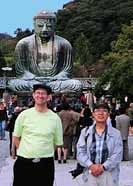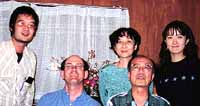
Riding the Rails - Eno-den and the DaibutsuNow things become more interesting, as I get away from Tokyo. I came prepared - a month before departure I purchased a JR East railpass at the Santa Clara branch of the Japan Travel Bureau (JTB), down there near Great America practically across the street from where I spent those three dreary months at Lockheed, when I first moved to the Valley of Heart's Delight. (MVS mainframes, QA stuff - the worst. But that was years ago, now.) Like in Europe, the railpass makes train travel a breeze, since you can bypass the ticket counter, and here they can be an incredible deal - but in Japan things are a little more problematic because the stations lack those yellow posters listing all the trains, their type, departure times and destinations. Bigger Japanese stations do have an assist - over the turnstiles are marquee-style boards showing the next few departures; but only in the biggest stations do these destinations alternate between kanji (characters) and romanji (letters spelling out the names). But that's not so tough for me; kanji is my strength since I've been studying them on & off for years (unlike the spoken language, an inadequacy I really must address before my next trip). During my second trip I had a general JR pass, the cheapest of those last a week and cost a little over $300 now; but since Kyoto wasn't on my agenda this time that was unnecessary and just in time I discovered that JR East has their own pass. (JR is actually a consortium of six regional railways -= there's also JR Kyushu, JR Shikoku, JR Hokkaido, etc.) The low-end East pass only lasts five days but is priced at under $200, the extra days would've been fun but as it was everything worked out fine.So this morning I checked out of the Fukudaya and walked down the hill to Shibuya station, pausing for a breakfast of a can of hot coffee from a vending machine and a pastry from a bakery. After hanging around a bit, the right office-bureau opened, where my voucher was converted into the actual pass - shortly thereafter I was riding a limited express along the ancient Tokaido Road,* which connected Edo (Tokyo) and Kyoto. At Fujisawa, past Yokohama, I called up my co-worker's brother, the venerable Hiroshi-san, and gave him my position at the terminus of the Enoshima Electric Railway, or the "Eno-den" - my plan was to ride ahead on this train and then have him pick me up at Ofuna where we'd originally agreed to rendezvous, but he'd have none of it - insisted on fetching me right from there. So I waited in front of the adjacent Odakyu department store for about forty-five minutes, watching the trains roll into and out of the station on the single track. A little kiosk-stand there was selling Eno-den souvenirs - everything imprinted with pictures of this train, which runs along the coast with views of Enoshima Island and (on clear days) Mount Fuji. It's beloved, I suppose, for its scenic route and the classic rolling stock still in use, especially the rounded mid-century-vintage green and yellow cars. Also, if you want to take a train to the Great Buddha that's your only option. Since it's a private railway my JR pass would not be valid; but as it turned out, my host would not allow me to pay for my ticket anyway. After a clarifying chat with a couple of confused schoolteachers from Annapolis, this semi-flustered, wizened little native wearing a baseball cap approached and we introduced ourselves, then went out to his car, waiting in a no-parking zone with his wife at the wheel. Then his son showed up and we were off. Traffic was lousy (since it was the weekend) and the Mrs. wanted to do stuff other than sight-see, so when they came to the realization their crazy foreign charge actually wanted to ride the train she dropped us off at the station and we rode on to Hase.
Here I disembarked with Hiroshi and his son Tetsushi.
They took me up a hill to the nearby Hasedera
Temple, a big complex of several buildings and
gardens overlooking the bay. Inside a big hall was
a large, multi-headed, gilded statue of the
Kannon god; I remember also being taken through
some cramped caverns where religious images had
been hewn into the rock walls a long time ago.
Then we walked across town to the Daibutsu or
Great Buddha, the Japanese variant of
Out on the street we passed a bamboo and basket shop and I got the answer to something which has been bugging me for a while - one of those flat-coned hats was in the display and I asked what they call it, described how they're known as "coolie hats" in my culture (or even "chinaman hat") but that sounds so derogatory, there must be a more politically correct term, and here it is: the Japanese word is gasa. (Hiroshi-san had to muse a bit before he remembered this.) Back to the Eno-den, which we rode on to Kamakura, the end of the line. Although it was dusk they took me down the long Dankazura (a pedestrian-only promenade surmounted by three torii gates) leading up to the Tsurugaoke-Hachiman-Gu (the Hachiman Shrine). My hosts said the trees bordering this boulevard were cherry trees, that these sakura were very beautiful in the spring. (I described those in my hometown of Washington, DC; how they'd been attacked by beavers last spring and how new, replacement trees are now being grown genetically identical to the original pre-war gift-trees from Japan; from cuttings, rather than just replacing them with commercial cherry trees.) As we ascended the long flight of steps up to the main shrine building, a wedding party in traditional garb passed us on their way down. We walked back along the Komachi-dori shopping street which runs parallel to the Dankazura - this I found much more interesting even as they subtly hurried me along (think they were getting hungry). Near the station, we caught a cab back to their home, the final kilometer winding up a hill past suburban houses, their details hidden in the darkness. My curiosity very high at this point - would the inside be a wonderland of sliding shoji doors, warm paper lanterns and tatami mats? As it turned out, no - not a traditional room anywhere in the house, regular (Western) tables and chairs everywhere, although I did have to remove my shoes at the threshold, as expected. (There may have been more traditional decor upstairs, but I wasn't invited up into that inner sanctum.)
Dinner was prepared by Noriko, the charming lady of the
house. It included sashimi (toro tuna - I really
was an honored guest), red wine (and daughter Yuko's
favorite beer, Yebisu), delicious soup with boiled
chicken, something with chunks of cold pumpkin (as
Noriko pointed out, an acknowledgement of
Halloween - the only one I noticed all day). Although
they all spoke understandable English, Yuko got out
the electronic Japanese/English dictionary unit to
assist with conversational subtleties - one of those
little hand-helds which resemble a pocket calculator.
After dinner, the inevitable photo session,
Eventually I fell to sleep in the spare room, my bed a futon on the floor. The only furnishings of note in there were a wooden shelving unit along one wall, loaded with chachkas, most rather dark and ancient except for a little model of the Eno-den. Next: TsumagoNote: * Ukiyo-e
fans are familiar with the 53 Stations thereof,
because of the famous print series by Hiroshige;
on-line links are available at the
Floating
World of Cyberspace - scroll down to
Hiroshige to reach them. |

